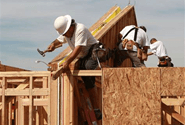Steel Markets

Housing Data Weakens in April
Written by Sandy Williams
May 18, 2021
April housing starts fell 9.5% to a seasonally adjusted annual rate of 1.57 million units, following March’s fastest climb since June 2006. Soaring construction costs and home prices were blamed for the April decline.
Single-family starts plunged 13.4%, although multi-unit homes gained 4%, said the U.S. Census Bureau and the U.S. Department of Housing and Urban Development in an announcement today.
Permit authorizations, a future indicator for housing construction, inched up just 0.3% from March. Permit authorizations for single-family homes fell 3.8% but authorizations for apartment-style homes of five units or more rose 11.1%.
“Housing production declined in April due to rising prices and limited availability of lumber and other building materials,” said Robert Dietz, chief economist at the National Association of Home Builders. “Single-family housing starts are up 28% on a year-to-date basis; however, the numbers are distorted by the weak readings of the spring of 2020.”
“Builder confidence remains solid in spite of supply-side challenges, according to the NAHB/Wells Fargo Housing Market Index (HMI),” said Dietz. “However, after peaking at a level of 90 last November, builders report growing concerns over increasing lumber and other construction costs, as well as delays in obtaining building materials. Rising interest rates will also erode housing affordability in 2021, though rates have fallen back in recent weeks. Builders also report growing concerns about a more challenging regulatory environment that could limit land development volume.”
NAHB is predicting that early 2021 weakness in single-family home construction will give way to the “long-run post-Great Recession trend as the year progresses.”
Regional data compared to the previous month shows permits up 8.4% in the Northeast and 3.9% in the South. Permits declined 9.9% in the Midwest and 4.1% in the West.
Housing starts grew 6.2% in the Northeast and 9.0% in the West, but plunged 34.8% in the Midwest and 11.5% in the South.

Sandy Williams
Read more from Sandy WilliamsLatest in Steel Markets

CRU: Sheet import demand softens as domestic price gains have slowed
US domestic sheet price gains have begun to slow as previously pulled-forward demand has led to a decline in orders.

CMC looks beyond Arizona micro-mill woes to long-term viability of construction mart
Despite the economic and geopolitical upheaval of the last five years, CMC President and CEO Peter Matt points out that the construction market has been an essential element of the way forward.

US importers face stricter rules under revamped S232 tariffs
“CBP expects full compliance from the trade community for accurate reporting and payment of the additional duties. CBP will take enforcement action on non-compliance," the agency said in a March 7 bulletin.

Steel exports rebound in January
US steel exports recovered to a five-month high in January after having fallen to a two-year low in December. This growth follows four consecutive months of declining exports.

Construction spending drops marginally in January
Construction spending edged down slightly in January, slipping for the first time in four months. The US Census Bureau estimated spending at a seasonally adjusted annual rate of $2,196 billion in January, down 0.2% from December’s downward revised rate. The January figure is 3.3% higher than a year ago. January’s result, despite the slight erosion, […]
